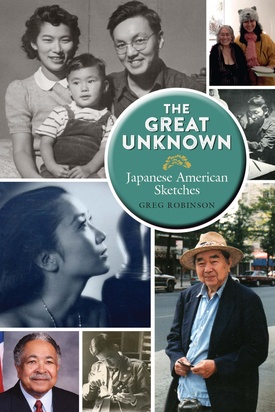In Kenji Taguma’s resplendent foreword to this latest of historian Greg Robinson’s cavalcade of exemplary volumes devoted to illuminating the Japanese American experience, he rightly observes that The Great Unknown is a work that “epitomizes the importance of the community press in preserving history.” Of course, had Taguma and his allied supporters within the Nichi Bei Foundation not labored so mightily and resourcefully to keep alive the most venerable of the Japanese American community newspapers, the columns underpinning Robinson’s book in all likelihood would never have been written. Now then, with this backdrop in place, let me pose the following query: Had Greg Robinson’s “The Great Unknown and the Unknown Great” 2007-2012 columns in the Nichi Bei Times and the Nichi Bei Weekly not appeared in print, what difference, if any, would this hypothetical situation have made to our understanding and appreciation of Japanese American history? Naturally, those of you who elect to become readers of “The Great Unknown” will respond to this question in your special ways, but please indulge me while I share with you my considered response.
In her immensely significant 2016 Verso book Serve the People: Making Asian America in the Long Sixties, Karen Ishizuka advances an astute observation that provides me with a point of departure for formulating a reply to my rhetorical question. In a section of her study titled “Recovering the Past,” Ishizuka describes historical recovery as a “major theme” of the 1960s-1970s Asian American movement, one that has left a “tangible legacy.” Elaborating on this contention, she writes: “Recovering history was not just an intellectual pursuit, it was critical for political longevity. Without an historical understanding, every generation of activists thinks it is the first. We did. We had no idea of the legacy and long history of Asian American resistance [to racism and imperialism].” I certainly agree with Ishizuka that the tradition of resistance to oppression by Asian Americans is both deeply rooted and substantial, and in my own work on Japanese American resistance I have labored to document its historically robust quality.
I would argue, however, that the brand of historical recovery undertaken by Greg Robinson within the pages of The Great Unknown relative to the Japanese America past, while assuredly akin to that articulated so consummately by Ishizuka, is both dissimilar to and more comprehensive in character than it. Clearly, Robinson’s historical recovery process applies primarily not to particularly striking “unknown” group actions or social movements of consequence, but rather to the “unknown” activities and/or achievements of selected noteworthy individuals. Thus, the book’s ten chapters exhibit such component units as: “The Hidden Contributions of Guyo Tajiri,” “Masuji Miyakawa: First Issei Attorney,” “Yasuo Sasaki: Poet, Physician, and Abortion Rights Pioneer,” “Arthur Matsu: First Japanese American in the National Football League,” “Shinkichi Tajiri: Sculptor,” “Kiyoshi Kuromiya: A Queer Activist for Civil Rights,” and “Gordon Hirabayashi’s Surprising Postwar Career.”
In addition, Robinson’s species of historical recovery, while it entails a distinct concern for exhuming a usable Japanese American lineage to fortify ongoing community resistance to domination and persecution, greatly transcends this bounded instrumental objective. Instead, his apparent goal is to remind his Nikkei and non-Nikkei readers alike that the Japanese American backstory was far more colorful, complex, and cosmopolitan than it has been typically chronicled to be through history and memory, and that in fact the community’s past was populated by a variety of “great” people (mostly but not exclusively Nikkei) whose thoughts and deeds can be resourcefully exploited by subsequent generations to inspire and enrich their personal and collective pursuits. To facilitate his ostensible aim, Robinson organizes his volume into subject chapters designed to vividly elucidate it: Issei women, mixed-race Japanese Americans, literature and journalism, wartime confinement, sports, arts, and Japanese Americans’ queer heritage.
Having read most of the selections in The Great Unknown when they originally appeared as newspaper columns, I was nonetheless overwhelmed during my reading them anew within a published book. Each of them attest to Robinson’s insatiable curiosity about and unquenchable passion for virtually every aspect of Japanese American history, society, and culture; his extraordinary expenditure of time and energy in unearthing previously unmined source material and extracting rich and engaging information and perspectives from it; and his enthralled devotion to converting his findings into fluid narrative prose pieces that are lively, thought-provoking, and far-reaching.
I wholeheartedly agree with the trenchant conclusion of Kenji Taguma’s foreword wherein he asserts that, while many of the individuals sketched by Greg Robinson in The Great Unknown may be unsung heroes, his book has ensured that they are no longer unknown. This is truly a first-rate book, and the University Press of Colorado is to be applauded for making its contents available to a wide audience (which, hopefully, will become still wider if and when it is made available in a paperback edition).
THE GREAT UNKNOWN: JAPANESE AMERICAN SKETCHES
By Greg Robinson
(Boulder, Colo.: University Press of Colorado, 2016, 400 pp., $45, hardcover)
*This article was originally published in the Nichi Bei Weekly on January 1, 2017.
© 2017 Arthur A. Hansen / Nichi Bei Weekly








